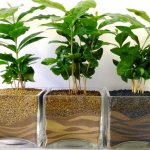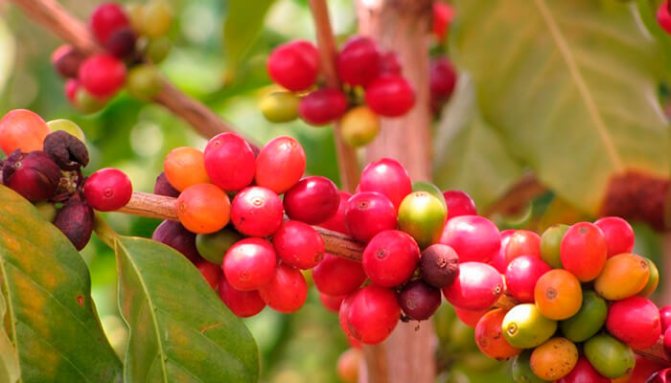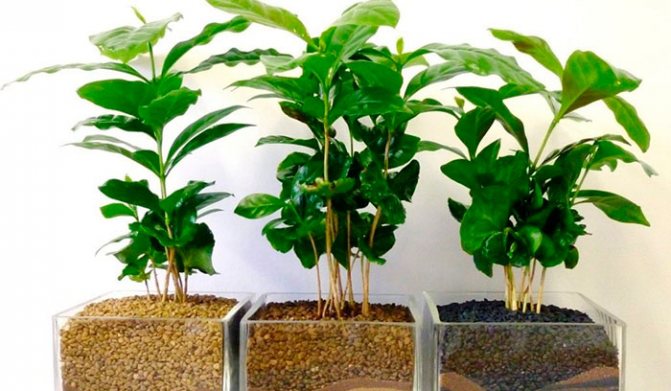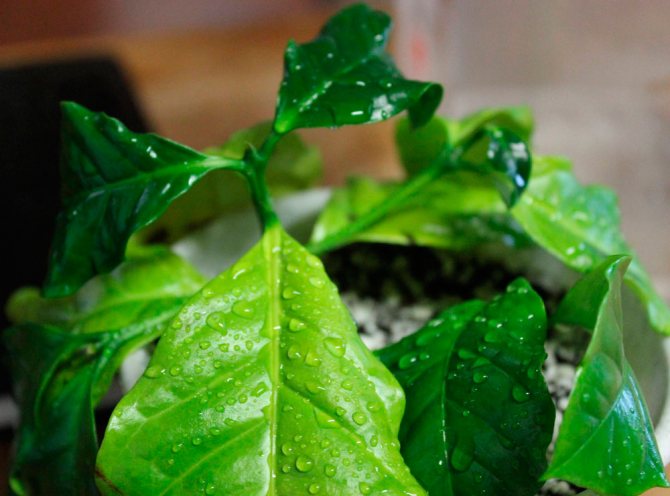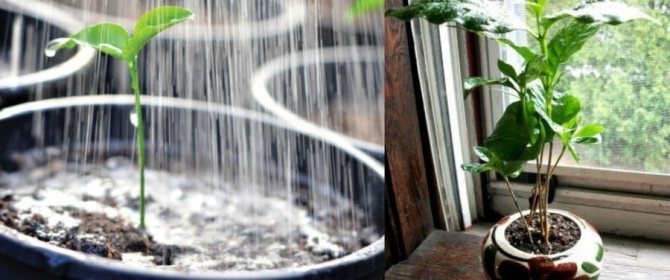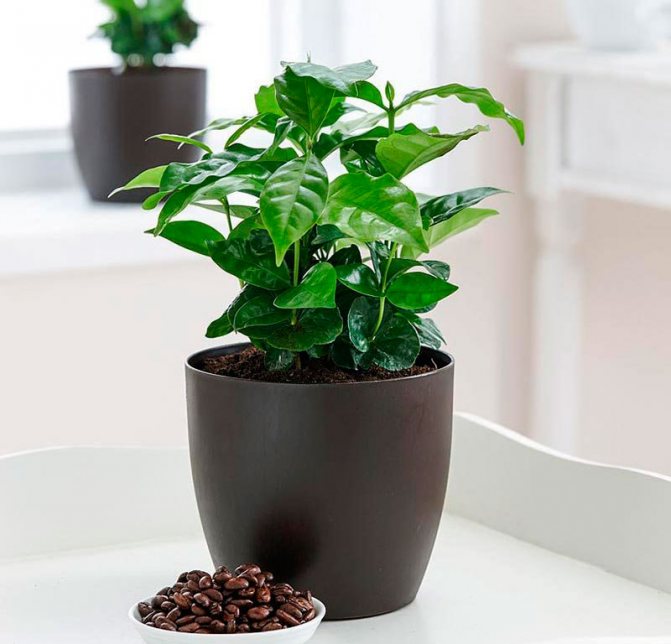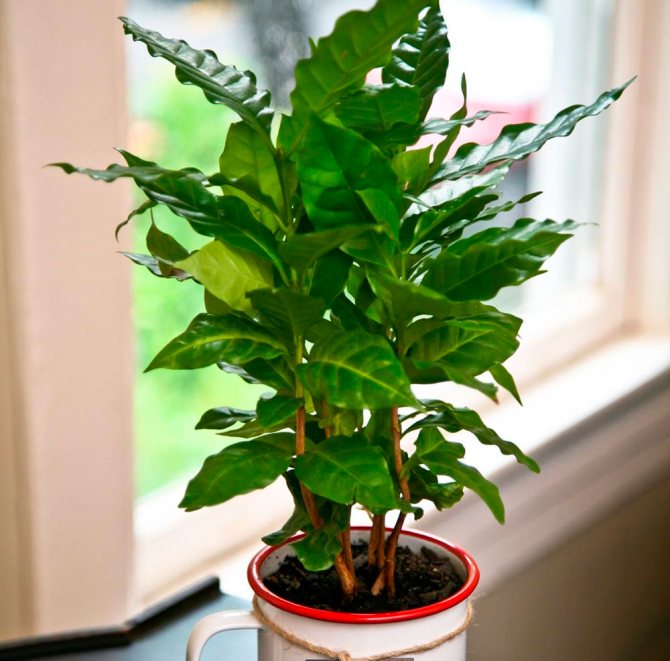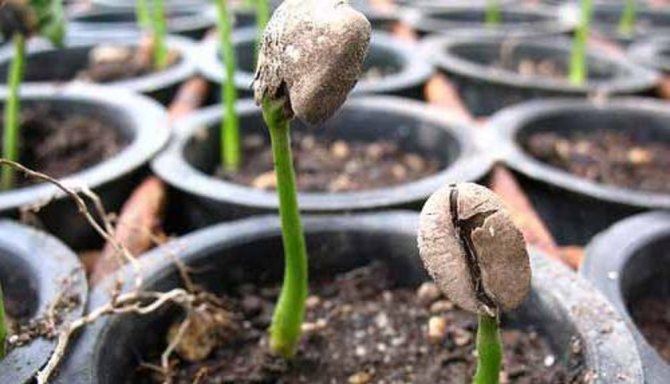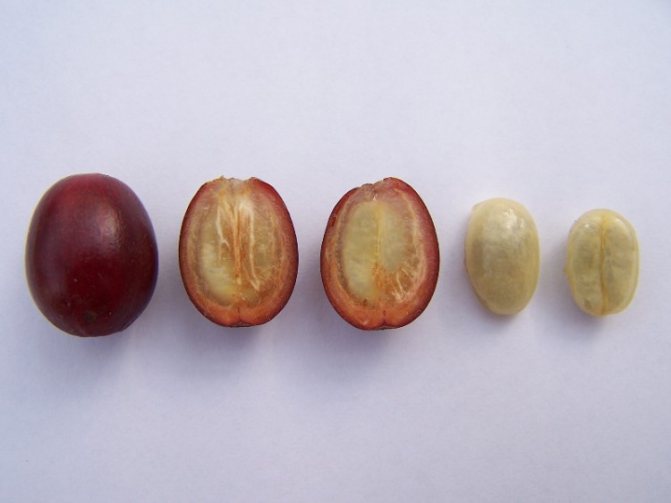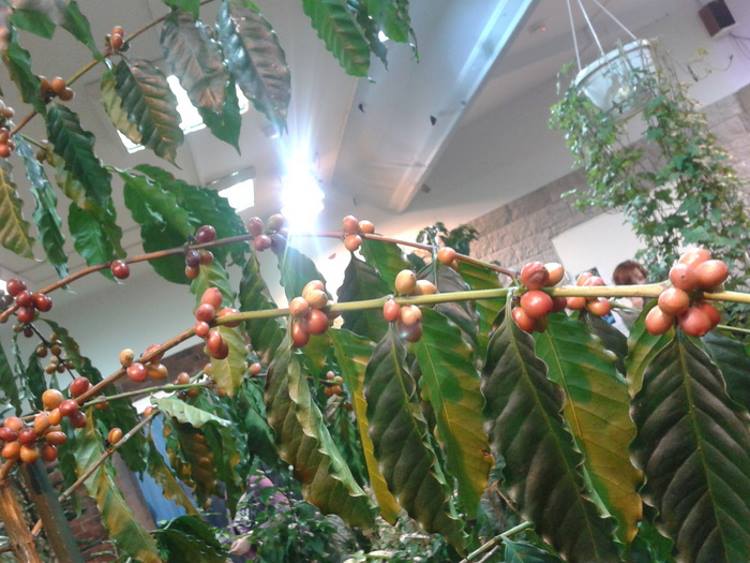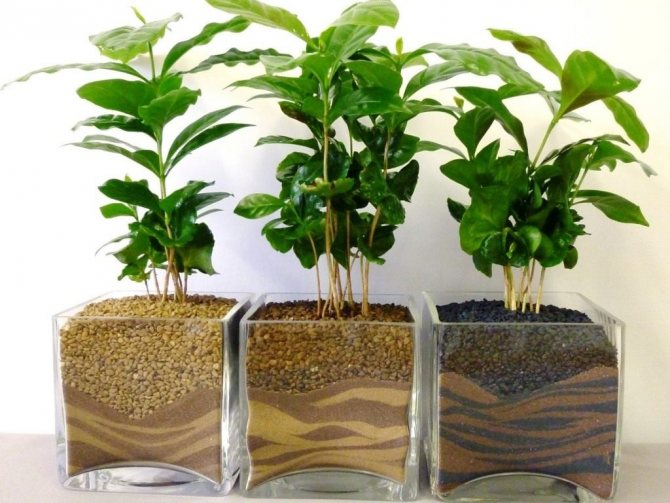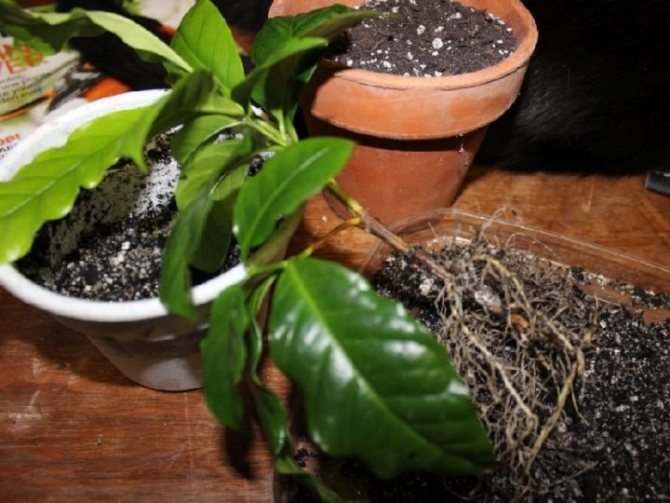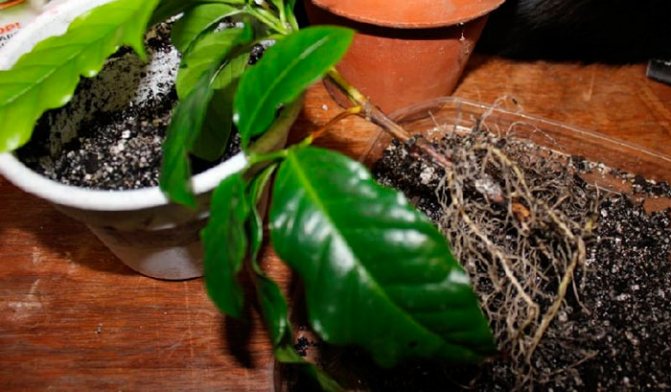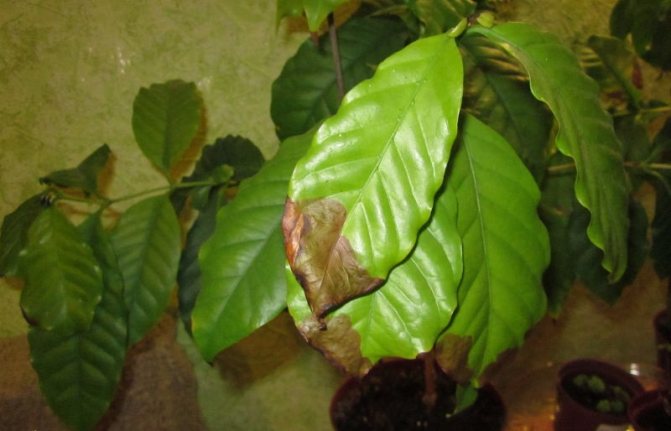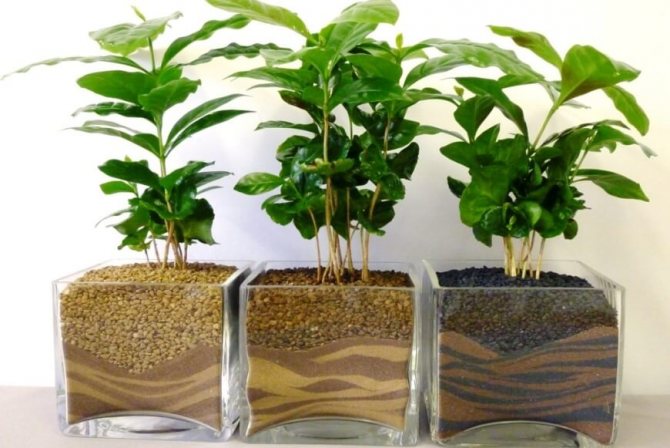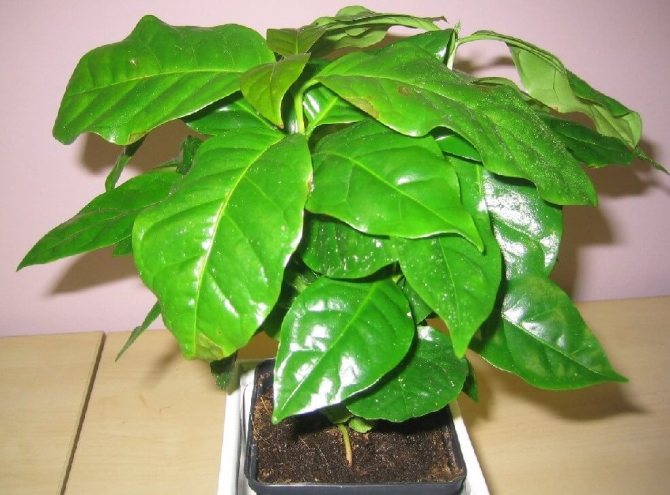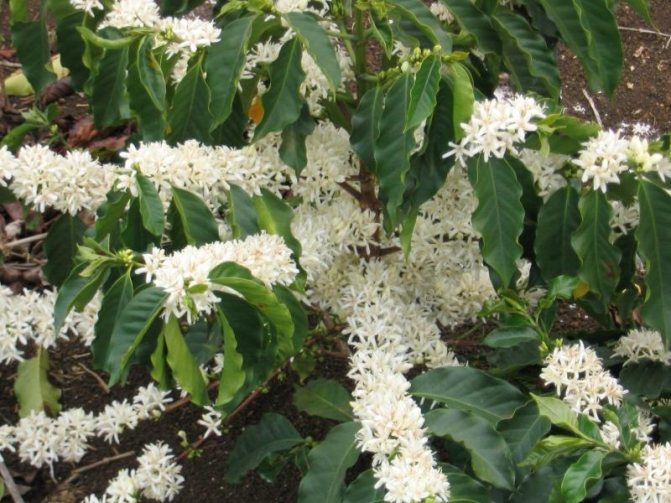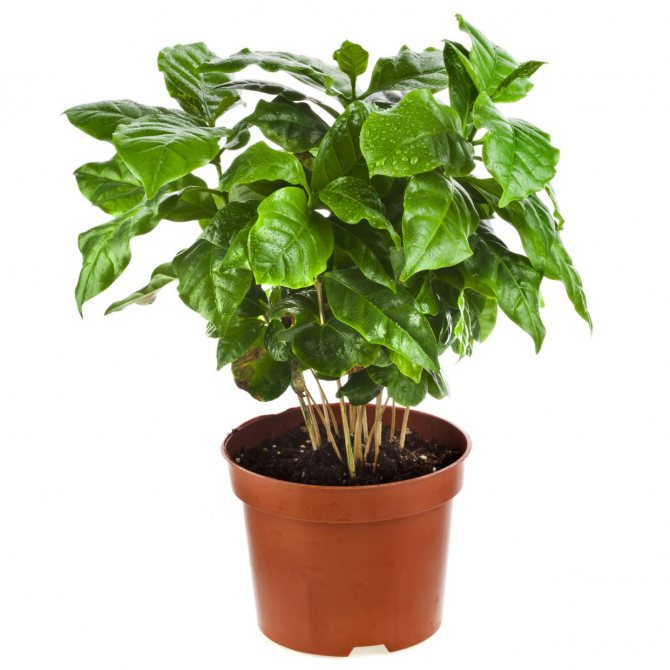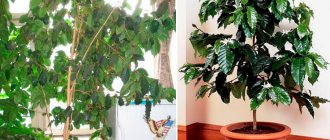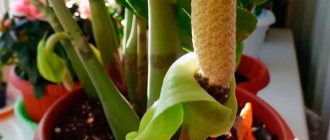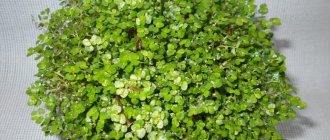Variety selection
The species of the coffee tree determines the quality of the grain drink and the possibility of growing in an artificial environment. Not all of the many coffees are suitable for indoor use.
The collection of coffee beans is made from the following types of trees:
- Arabian;
- Congolese;
- Liberian;
- excelsian.
Arabica coffee is of the greatest interest. The less demanding robusta has a high yield, but loses to noble Arabica in taste and aroma. Saturated with subtle aromas, a drink made from Arabica beans has a mild taste without excessive bitterness. Rare types of Liberic and Excels are inferior in taste to Arabian coffee and are more often found in blends.
Of all types of coffee trees, Arabian Arabica and dwarf varieties (Nana, Albert) are suitable for cultivation in a home environment. Congolese tree (robusta), liberica and excelsa are usually grown on plantations, where these large plants reach a height of 10 to 25 meters. Robusta is less demanding on climatic parameters and soil condition, but does not bear fruit in a room setting due to cross-pollination of flowers.
Description and features of room coffee
Arabica trees in natural conditions reach a height of 5 - 8 meters. When grown at home, coffee forms a small tree or bush, barely reaching the height of 150 cm. In rare cases, the plant grows up to 2 meters. Low-growing varieties (dwarf) grow up to 50 - 80 cm.
Developed indoor coffee bushes have lignified stems with evergreen branches.
Large oval leaves with a wavy surface form a colorful crown of rich green color
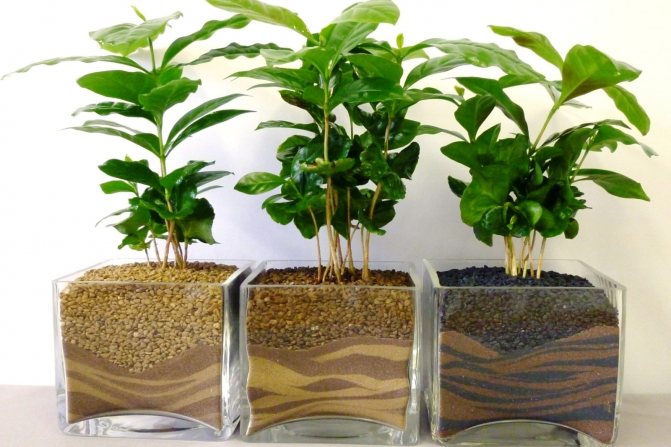
Arabica is a self-pollinated variety, therefore, with proper care, it retains good fruiting ability in an artificial environment. In the short-term flowering period (on average about 2 days), the plant dissolves snow-white inflorescences. From the ovaries of coffee flowers, fruits are formed.
Coffee blooms beautifully, exuding a characteristic aroma, twice a year - in late autumn and spring
The fruit of the coffee tree is round in shape. The color of the dense skin of the berries changes during ripening, which lasts 6 - 8 months, from a pale green to a red or brick-orange hue.
Secrets of the coffee tree
Ripe fruit with a sour pulp contains from 1 to 3 seeds inside - coffee beans
Under natural conditions, one tree produces 3-4 kg of grain per season. A coffee tree at home can produce 300 - 500 grams of grain. In order for indoor plantings to bear fruit, it is necessary to plant the plant correctly, transplant it in a timely manner and create a favorable microclimate.
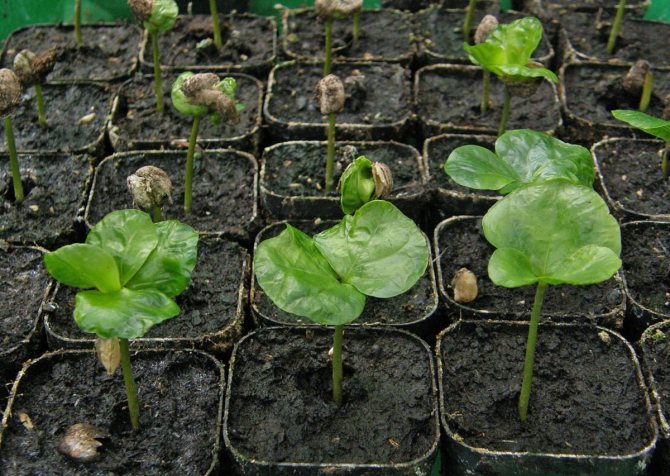

You can buy indoor coffee tree in the following ways:
- buy in the form of a seedling in a flower pot;
- root the stalk;
- grow from a seed.
The rate of development of the plant and its endurance depend on the method of planting coffee at home. In any case, it is necessary to prepare in advance a suitable substrate for growing and transplanting a bush.
Ground requirements
The substrate for growing a coffee tree must be loose for root respiration and nutritious.The plant prefers acidic soil, so soil mixtures based on acidic peat are suitable.
You need to prepare the soil 10 - 14 days before planting. To do this, mix the following components:
- 2 parts sour peat;
- 2 pieces of sand;
- 1 part leaf turf.
A mixture of equal parts of black soil, turf, humus, sand with 2 parts of sour peat is also suitable. Lightweight universal primer can be used.


Before planting, the soil is thoroughly moistened. The coffee tree loves moisture, but does not tolerate its stagnation. Therefore, care must be taken to drain excess water. To do this, a drainage layer is poured at the bottom of the flower pot. Place the main soil on top. This principle is followed when planting and transplanting coffee.
When is the harvest expected?
When sprouting a tree from grains, the first fruits will appear no earlier than four years later. A tree grown from a cutting ensures fruiting already in the first year of flowering.
If you follow all the above rules for caring for coffee, you can get not only a source of a delicious drink, but also a decoration for your apartment. All kinds of decorative elements can be created from the grains.
Coffee is believed to help fight migraines and fatigue. It is used to dilate blood vessels and increase blood pressure. Occasionally it is used for poisoning.
It should be noted that according to the rules of Feng Shui, this tree has a number of unique properties. It is believed that when it is placed in the home, the well-being and relationships in the family are improved. This plant is recognized as one of the types of money tree.
By placing this tree in the bedroom, a long and strong family life is guaranteed. This plant attracts positive energy into the house, which is already a reason to start growing a coffee tree.
Planting coffee with a handle
Propagation of coffee trees by cuttings allows us to expect flowering as early as 2 - 3 years after rooting. The main points are the availability and quality of planting material. The cuttings must be taken from a healthy plant.
For planting, a stalk is selected from the middle part of a branch with two pairs of leaves. The cut is made with a sharp knife obliquely, retreating downward from the extreme kidney by 2 - 3 cm.
The cutting is planted in the following order:
- Preparation of planting material. To speed up the rooting of the cutting, it is kept in a root formation stimulator (Kornevin, Epin, Zircon) for the time specified in the instructions for the preparation.
- Soil preparation. A sand-peat mixture of equal proportions of sand and sour peat with the addition of sod is used as a substrate. The soil is thoroughly moistened.
- Planting the cuttings. The stalk is placed in the ground, placing it straight, to the level of the lower kidney.
- Creation of gentle conditions for the seedling. For the plant to take root more easily, it needs a warm and moderately humid environment. Therefore, the stalk is covered with a glass jar or a transparent plastic bag with a small hole for air exchange.
A signal that it is time to transplant a young plant is the appearance of a new pair of leaves.
Growing coffee from beans
It will take longer to successfully grow a coffee tree from a bean. Bean coffee, which is sold in stores and coffee shops for the preparation of the drink, is not suitable for planting. Even if it is green coffee, the beans have been minimally processed and not harvested anytime soon.
For planting, you need to buy fresh, unprocessed grain. The period from collection of seeds to sowing should not exceed 45 days.
You can buy quality planting material in specialized stores. An alternative is to plant a fresh coffee berry or coffee beans. This is the best option if you can get the fruit directly from the tree.
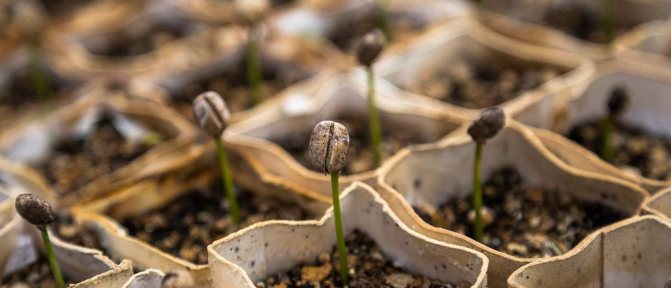

Grain from the store must first be soaked in a solution of a complex growth stimulant, in a slightly pink solution of potassium permanganate or in plain water. To speed up the germination of the seed, you can carefully cut the dense shell with a knife before soaking.
Landing is carried out in the following order:
- place the grain in prepared and moistened soil to a depth of 1.5 - 2 cm with a flat surface down;
- sprinkle with earth on top;
- watered;
- covered with a glass jar or a layer of polyethylene.
The shelter is removed as the first leaves are freed from the fetal membrane. Planting a whole berry or seed, separated from the pulp immediately before starting work, takes place in the same order without preliminary soaking.
The seeds germinate 30 to 90 days after sowing. When planting whole berries, this period extends to six months. The first flowers on a seed-grown coffee tree can be expected in 3 to 4 years.
Reproduction
There are two methods for obtaining a full-fledged plant:
- seed;
- stalk.
Seed reproduction
The coffee seeds are usually not roasted. Germination stages:
- Scarify the grains (destroy the shell). This process is carried out by a chemical (rapid lowering of the seed in gauze into sulfuric or hydrochloric acid) or mechanical (incision, cut) method.
- Soak the prepared grain in a growth stimulant (Zircon, Epin or Kornevin).
- Prepare the soil in advance (preferably half a month before disembarkation). It should consist of steamed sod land (one part), peat and sand (two parts), you can add ash.
- Pour drainage, prepared substrate into the pot, take a seed and deepen it with the flat part down into the soil by about 1 cm.
- Drizzle, cover with transparent material (glass, film).
- Expose to light, but not in direct sunlight. Maintain the room temperature + 20… + 25 ° C.
- Periodically remove the cover and spray the planting.
If you follow the rules in a month, the grains should hatch. When leaves appear, it is necessary to transplant. The pot should be taken with a diameter of no more than 7 cm, but deep enough. It is imperative to protect the seedling from the sun. After a month, repeat the transplant, taking a container of a larger diameter.
Cuttings
This method has several advantages:
- 100% result if the rules are followed;
- the properties of the mother tree are completely transferred to the new;
- the time for growing a full-fledged plant is reduced, which means that you can get the first harvest faster;
- the growth of the tree occurs in width.
Stages of cuttings:
- Prepare the substrate, for this use a mixture of perlite and peat. It should be loosened, oxygenated and moisturized.
- Pour the prepared soil with a weak solution of potassium permanganate for disinfection.
- Prepare a stalk, for this, select a one-year-old branch from the middle of an adult tree, cut it off three centimeters below the leaf with a sharp knife.
- In the lower part, along the freshly cut branch, make scratches with a needle for better root formation.
- Place the cutting in a solution that stimulates the growth of the root system for three hours. For example: a tablespoon of honey in 200 ml of water or ¼ Heteroaxin tablet in 1.5 liters of water.
- Place it vertically to dip only the bottom. Then plant the stalk in the soil, deepening it by about three centimeters, so that the part under the bottom sheet is all in the ground. Cover the top with polyethylene (bag, foil) with holes for oxygen and moisture when spraying.
- Place the container in a shaded room. The optimum temperature for rooting the cuttings is + 25 ° C.
How to choose a coffee bush in a store
If you buy a ready-made young bush of coffee, the hassle will be less. When buying, it is necessary to inspect the flower for the presence of pests and diseases. The foliage should be bright and fresh, without aphids, cobwebs, spots on the surface, withered and twisted leaves.
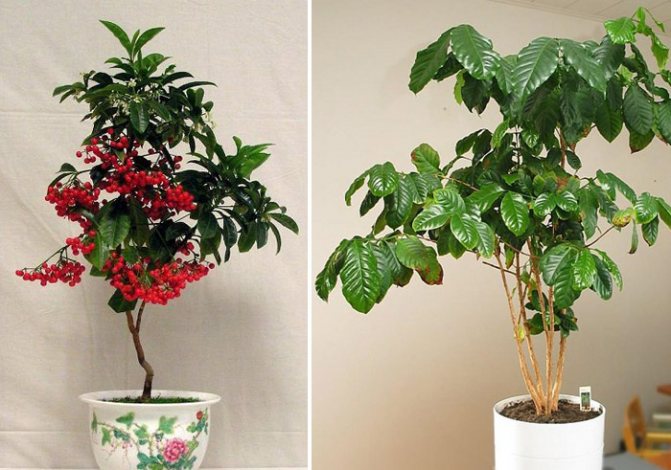

In the room, you need to find a suitable place, monitor the temperature, humidity and transplant the bush after the adaptation period. The plant's habituation to new conditions can be accompanied by tarnishing of the leaves and their dropping. Viable seedlings will successfully acclimatize if properly cared for.
Growing conditions
Coffee is not considered whimsical, but for the formation of the crown, the formation of flowers and fruits, it needs to create favorable conditions. For plantings to look healthy and develop properly, you need to know how to care for the coffee tree.
Temperature regime
The coffee tree thrives in moderately warm and humid climates. The plant is placed indoors at a room temperature of 20-23 degrees. Deviations of a couple of degrees are allowed depending on the season: in summer and spring - up to 25 degrees, in winter - up to 18 degrees.
In hot climates, the tree does not bloom or stops flowering, shedding its leaves. If the thermometer reads below 15 degrees, the plant may die.
Lighting requirements
The plant needs a lot of light, but the streams should not be straight. Intense sunlight has a detrimental effect on the development of the bush. The tips of the leaves dry out, and burns occur on the surface. To avoid the scorching rays of the sun on the south side, place the pot with the plant at a distance of at least 1 meter from the glass, shade a little.
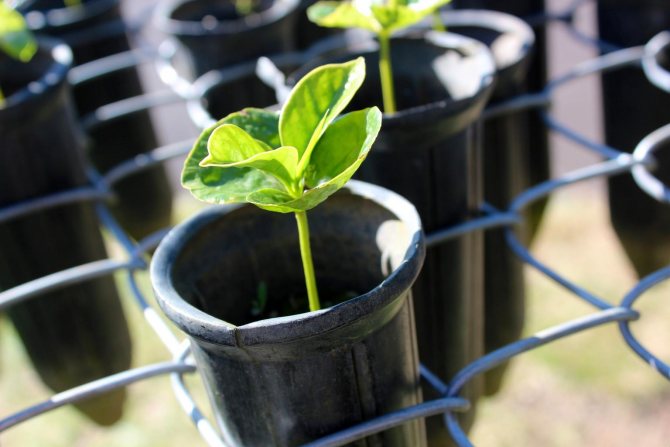

You cannot change the location of the coffee tree and rotate the flower pot.
Watering mode
The coffee tree needs regular moisture. Due to lack of moisture, coffee leaves become lethargic and pale. Watering should be carried out systematically, preventing the soil from drying out deeper than 10 mm from the surface. Too abundant watering, leading to stagnation of moisture, is contraindicated for the plant.
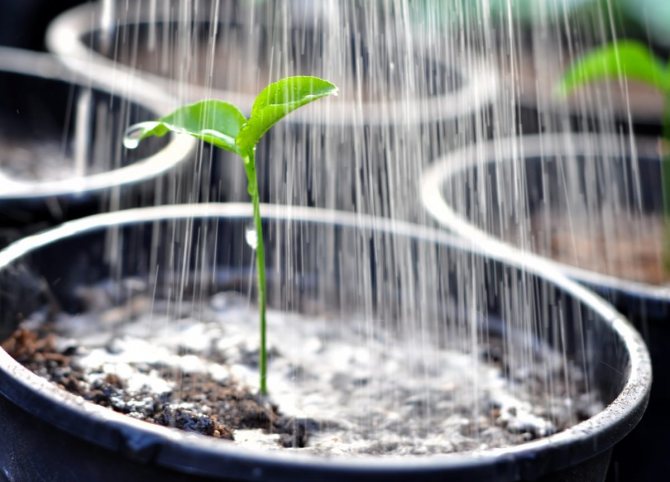

To water the coffee tree at home, use settled running water. Soft rain and melt water will do. The water temperature should exceed the reading of the room thermometer by a couple of degrees.
The watering schedule looks like this:
- summer period - once every 3 days;
- autumn-winter period –1 every 5–7 days.
In addition to root humidification, sufficient air humidity must be maintained. To do this, the crown of the bush is regularly sprayed with lukewarm water from a spray bottle.
Diseases and possible difficulties in growing
During growth, coffee is attacked by insects (spider mites, scale insects), diseases, in particular, fungi, develop.
For any of these problems, you need to wipe the foliage on both sides with a sponge dipped in soapy water. Only then can special preparations against parasites be used, such as Actellic or Karbofos.
Take 10 drops of any of these products and dilute in 10 liters of water. If the coffee is heavily infested with pests, then re-spraying is mandatory. The interval between treatments should be at least a week.
Alcohol is effective against aphids; both sides of the foliage are wiped with it. For fungus, copper sulfate is used.
It is also worth remembering a number of rules:
- when planted in insufficiently acidic soil, the foliage of the tree may turn pale;
- if the temperature in the room is below +10 degrees, the tree dies;
- if the air in the room is dry, foliage curls.
Transplant
Caring for a houseplant coffee includes the obligatory regular replanting. The need for a transplant arises when the development of the seedling, the size of its root system does not correspond to the volume of the flower pot. The first three years of life are accompanied by periods of active growth, therefore, young animals need to be transplanted every year. Over time, the transplant is carried out less often - once every 3 years.
The protrusion of the roots above the surface when the pot is completely filled indicates the need to transplant the bush. The new planting container should be 5 cm larger than the previous one.
Transplanting a coffee tree is carried out in the following order:
- select a flower pot that is suitable in size;
- distribute a drainage layer at the bottom;
- a layer of sand with a thickness of at least 1 cm is poured over the drainage;
- lay the soil prepared in advance to half the flowerpot;
- the coffee tree is placed in a container with a substrate along with part of the old soil;
- sprinkle with a substrate, filling the voids;
- watering the transplanted plant.
When placing a shrub in a new pot, leave the root collar above the soil surface. Additional soil application may be required as it settles in the flowerpot.
Transfer
For the first couple of years, coffee can be transplanted annually. This should be done in early spring, before the active growing season begins. Then the plant needs replanting less often - once every two years. Given that the tree has a well-developed root system, you should take care of a sufficient depth of the planting container (pot), and each time you need to increase the diameter by 2-4 cm.
Naturally, each transplant will be accompanied by a change of soil. It is better to choose a ready-made one, suitable for growing tropical plants. The soil must be necessarily slightly acidic, rich in phosphorus, organic matter. It is good to arrange drainage at the bottom.
You can compose the soil yourself. Regular garden soil should be mixed with peat, humus and river sand in equal proportions. It is good to add a handful of wood ash for balance.
The plant forms a crown on its own and without special need it is better not to interfere with this process. An exception is the excessive stretching of the tree in height, when it no longer fits in the proposed space. In this case, you will have to correct the shape.
Fertilization
When grown at home, the coffee tree needs periodic feeding. Rational fertilization stimulates plant growth and development. A strong coffee tree begins to bloom and bear fruit more actively.
As fertilizer for the coffee bush, universal complexes that can be purchased at the store are suitable. The composition must contain the following elements:
- nitrogen;
- potassium;
- phosphorus.
From organic matter, chicken droppings and mullein are suitable for feeding.
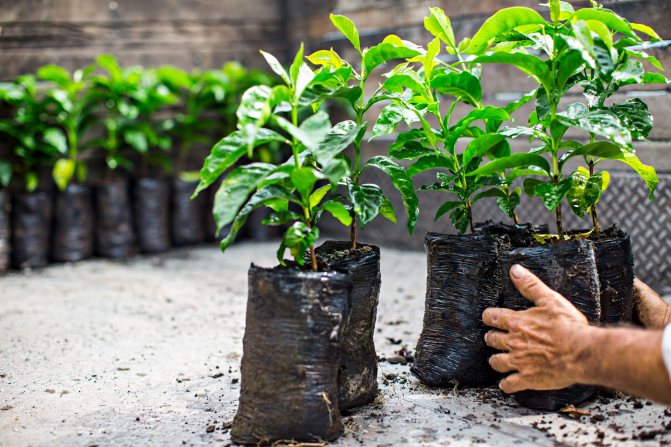

In order for the plant to bloom faster, it is necessary to make additional nutrition in the spring-summer season. During this period, feeding is carried out 2 times a month. In the autumn-winter time, it is enough to fertilize the shrub 1 time in 30 - 40 days.
Use diluted lemon juice to restore a healthy and fresh look to tarnished coffee leaves. 10 ml of freshly squeezed lemon juice is diluted in 1 liter of water. The leaves are wiped with a solution, and the flower is watered with the rest.
Care after purchase
So how to grow Arabica coffee at home? The coffee tree is famous for its unpretentiousness, but this does not mean at all that it does not need care and creation of the necessary conditions.
REFERENCE! The first thing to think about before buying is the presence in your apartment of the space that the tree needs. The fact is that Arabica can grow to the size of a two-meter bush.
Position the plant so that the sun's rays do not directly hit the leaves. Sun exposure can cause burns on delicate leaves. At the same time, Arabica loves bright lighting, it is desirable that it be a little diffused.
If there is a lack of natural light, phytolamps can be installed. This will create additional lighting. The most comfortable coffee will feel on the windows facing east or west.
ATTENTION! The homeland of Arabica is the tropical lands of Asia and Africa. It is there that this species grows wild.
The climate in Russia is not suitable for coffee, so attempts to create a plantation on your own farmstead will not achieve the expected result. Arabica will not survive the cold season.
Watering


Arabica has an active period and a period when the plant goes into hibernation.
The active period falls on the warm part of the year, from about March to October. At this time, Arabica needs the soil to constantly maintain moisture and not dry out. During hibernation, water consumption decreases.
It is better to pre-settle water for irrigation or use filtered purified water.
REFERENCE! In an effort to maintain soil moisture, you cannot overdo it and create an artificial swamp. If you overdo it with moisture, then there is a danger of rotting of the root system.
Top dressing should be carried out during the active period. Fertilizer should be added to the irrigation water once a week.
ATTENTION! Fertilizer should not contain calcium.
In the cold season, a rest period begins. During this period, watering should be reduced. It should also be borne in mind that evaporation in winter is less intense than in summer.
REFERENCE! In addition to watering, Arabica needs constant spraying. For a plant, indoor air humidity is of great importance. It is especially important to spray the leaves during the heating season, when the air in the apartments becomes especially dry.
Bloom
The coffee blooms in a delicate white color. The delicate petals of the Arabica coffee flower are fragrant with a rich pleasant aroma. Typically, the Arabica coffee tree begins to bloom in its third or even fourth year of life.
Subsequently, the flowers give way to small round red fruits. If, upon reaching the specified period, flowers do not appear on the tree, then you need to check whether the plant is being cared for correctly.
ATTENTION! Proper lighting is essential for the flowering of the coffee tree. The lack of colors can be caused by a lack of light.
Below are photos of Arabica coffee, home care for it allows you to achieve the following results:
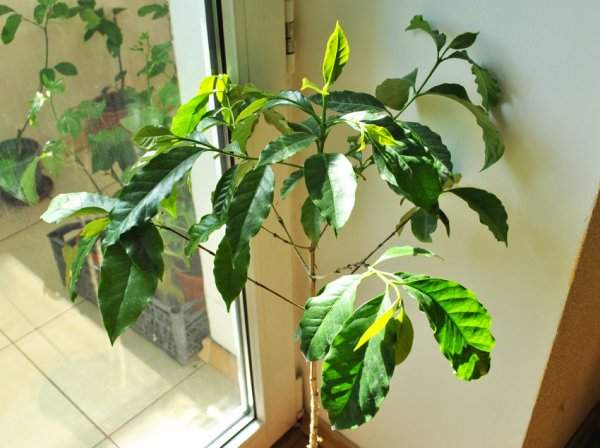

Priming
For Arabica, a slightly acidic soil will be most suitable. If it is not possible to purchase a ready-made coffee tree soil mixture, you can use a mixture for plants that also prefer acidic and slightly acidic soil. These plants include azalea or hydrangea.
REFERENCE! Before planting the coffee tree, make sure the selected pot is the right size. A thick drainage layer should be laid out on the bottom.
This is a prerequisite for all plants that need abundant watering. If the drainage layer is sufficient, then the water will not linger near the roots and create a risk of decay.
Transfer
Young coffee trees need to be replanted annually.
The best time of the year to transplant is Spring.
When the plant reaches a large size and stops growing, the need for regular replanting disappears.
It is enough to replace the top soil annually.

